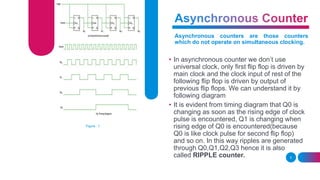Counters, Synchronous & Asynchronous Counters
- 1. 1 BSc. In Computer science & Engineering Khwaja Yunus Ali University Welcome to my Presentation
- 2. Md. Wahidur Rahman Lecturer Department of CSE Khwaja Yunus Ali university Khwaja Yunus Ali University Submitted By Course Teacher Bony Yamin Batch: 10th Student ID: 20202050500-11 Department of CSE Khwaja Yunus Ali university 2
- 3. A special type of sequential circuit used to count the pulse is known as a counter -According to Wikipedia 3 What Is Counter & it’s types ? 01 What is Synchronous counter & it’s design ? 02 What is Asynchronous counter & it’s design ? 03 Comparison between Synchronous & Asynchronous Counter? 04
- 4. Definition: A counter is register capable of counting the number of clock pulses arriving at its clock input. There’re Two Types of Counter There're Two Types of Counter Synchronous Counter Asynchronous Counter 4
- 5. Asynchronous counters are those counters which do not operate on simultaneous clocking. • In asynchronous counter we don’t use universal clock, only first flip flop is driven by main clock and the clock input of rest of the following flip flop is driven by output of previous flip flops. We can understand it by following diagram • It is evident from timing diagram that Q0 is changing as soon as the rising edge of clock pulse is encountered, Q1 is changing when rising edge of Q0 is encountered(because Q0 is like clock pulse for second flip flop) and so on. In this way ripples are generated through Q0,Q1,Q2,Q3 hence it is also called RIPPLE counter. Figure : 1 5
- 6. 6 The synchronous counter is a type of counter in which the clock signal is simultaneously provided to each flip-flop present in the counter circuit. Figure 2 : Timing diagram synchronous counter • Unlike the asynchronous counter, synchronous counter has one global clock which drives each flip flop so output changes in parallel. The one advantage of synchronous counter over asynchronous counter is, it can operate on higher frequency than asynchronous counter as it does not have cumulative delay because of same clock is given to each flip flop. From circuit diagram we see that Q0 bit gives response to each falling edge of clock while Q1 is dependent on Q0, Q2 is dependent on Q1 and Q0 , Q3 is dependent on Q2,Q1 and Q0. 6
- 7. In a synchronous counter, all the flip-flops are triggered by the same clock signal whereas in an asynchronous counter, flip-flops are triggered with different clock signals Synchronous Counters • Simultaneous clock signal is given to all the flip- flops connected in synchronous counters. • Speed is fast as no clock delay is provided to flip- flops. • Circuit is complex or complicated as number of states increases. • Cost is more as additional circuitry is required. • Synchronous counter is known as parallel counter. Asynchronous Counters • Clock is provided to first flip-flop and the output of first flip-flop acts as clock second flip-flop and so on. • Speed is slow as compared to synchronous counters as clock signal is delayed for other flip-flops except the first one. • Circuit ls simple. • Cost is less as compared to synchronous counters. • Asynchronous counter is known as serial counter 7








